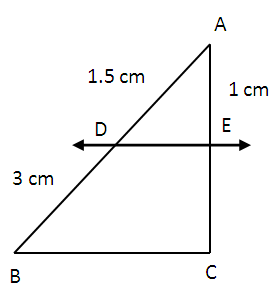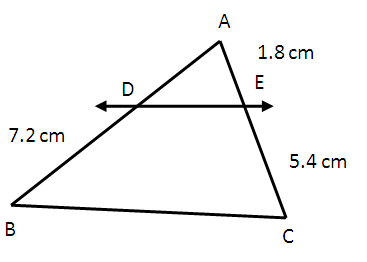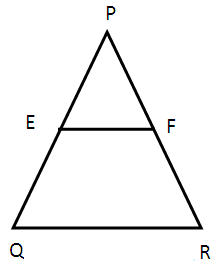FIND THE MISSING SIDE LENGTH USING BASIC PROPORTIONALITY THEOREM
Question 1 :
In the figure given below the sides DE and BC are parallel. Find the length of the side EC ?

Solution :
Let EC = x.
Given that :
The sides DE and BC are parallel.
By using basic proportionality theorem, we have
AD/DB = AE/EC ----(1)
AD = 1.5 cm, DB = 3 cm, AE = 1 cm
By applying the known values in (1), we get
1.5/3 = 1/x
1.5x = 3
x = 3/1.5
x = 2 cm
Hence, the length of side EC is 2 cm.
Question 2 :
In the figure given below the sides DE and BC are parallel. Find the length of the side AD ?

Solution :
Let AD = x.
Given that :
The sides DE and BC are parallel.
By using basic proportionality theorem, we have
AD/DB = AE/EC ----(1)
AD = x DB = 7.2 cm AE = 1.8 cm EC = 5.4 cm
x/7.2 = 1.8/5.4
5.4 x = 1.8 x 7.2
x = (1.8 x 7.2)/5.4
x = 2.4 cm
Question 3 :
E and F are points on the sides PQ and PR respectively of a ∆ PQR. For each of the following cases, state whether EF ∥ QR.

(i) PE = 3.9 cm, EQ = 3 cm, PF = 3.6 cm and FR = 2.4 cm
(ii) PE = 4 cm, EQ = 4.5 cm, PF = 8 cm and FR = 9 cm
(iii) PQ = 1.28 cm PR = 2.56 cm PE = 0.18 cm and PF = 0.36 cm
Solution :
Given that :
PE = 3.9 cm , EQ = 3 cm, PF = 3.6 cm and FR = 2.4 cm
PE/EQ = PF/FR ----(1)
3.9/3 = 3.6/2.4
1.3 ≠ 1.5
So, the sides EF and QR are not parallel.
(ii) PE = 4 cm , EQ = 4.5 cm, PF = 8 cm and FR = 9 cm
Solution :
According to basic proportionality theorem, we have
PE/EQ = PF/FR
4/4.5 = 8/9
0.88 = 0.88
So, the sides EF and QR are parallel.
(iii) PQ = 1.28 cm PR = 2.56 cm PE = 0.18 cm and PF = 0.36 cm
Solution :
PQ = PE + EQ
1.28 = 0.18 + EQ
EQ = 1.28 - 0.18 = 1.1
PR = PF + FR
2.56 = 0.36 + FR
2.56 - 0.36 = FR
FR = 2.2
According to basic proportionality theorem, we have
PE/EQ = PF/FR
0.18/1.1 = 0.36/2.2
0.1636 = 0.1636
So, EF is parallel to QR.
Kindly mail your feedback to v4formath@gmail.com
We always appreciate your feedback.
©All rights reserved. onlinemath4all.com
Recent Articles
-
Digital SAT Math Problems and Solutions (Part - 150)
Apr 25, 25 11:46 AM
Digital SAT Math Problems and Solutions (Part - 150) -
AP Calculus AB Problems with Solutions (Part - 19)
Apr 24, 25 11:10 PM
AP Calculus AB Problems with Solutions (Part - 19) -
AP Calculus AB Problems with Solutions (Part - 18)
Apr 24, 25 11:06 PM
AP Calculus AB Problems with Solutions (Part - 18)
